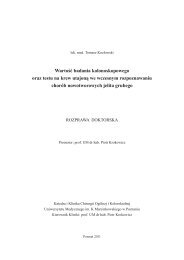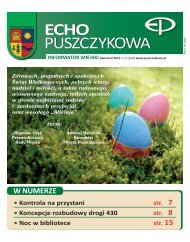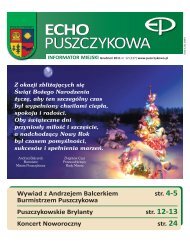MILITARY PHARMACY AND MEDICINE
MILITARY PHARMACY AND MEDICINE
MILITARY PHARMACY AND MEDICINE
You also want an ePaper? Increase the reach of your titles
YUMPU automatically turns print PDFs into web optimized ePapers that Google loves.
© Military Pharmacy and Medicine • 2012 • 4 • 10 – 16recommended to him/her by his/her physicianand that he/she started the treatment. How longshould the patient take the recommended product?And, what’s more important, when shouldthe patient expect to experience an improvementin vision? There are no satisfactory answers tothese well justified (as the patient does not get theproducts for free — he/she buys them) questions,as the beneficial effect will surely not be observedafter the first month, or even after the first severalmonths of using the dietary supplement(s); insome patients, the effect may be observed after along-term use that lasts many months, and evenyears. What’s more, there may be no effect at all!Patients may feel disappointed with such “supplementationtherapy”, while the manufacturer ofthe supplement holds no responsibility whatsoever,as they may always bring up what is alreadywell known, i.e. that the product is a dietary supplement,and not a drug! A question/statementoften raised in such cases by the supporters of“supplementation therapy”, i.e. what if the supplementshad not been taken, is purely rhetoricalone. Indeed, there is no answer to this question.Patients disappointed with their hitherto ineffectivetherapy, i.e. patients with conditions refractoryto the established pharmaceuticals or patients withconditions with no pharmacological treatmentavailable are particularly susceptible to the use ofdietary supplements. Cases where no specific drugsare available — as in the case of AMD — favorsall kinds of therapeutic speculations and paramedicalactivities, opening a lucrative area for themanufacturers and suppliers of dietary supplements— appropriately promoted dietary supplementsmay even be perceived as drugs!The abundant offer of dietary supplements availableat Polish market and targeted at individualssuffering from AMD or at risk of AMD includesnearly 100 products of the OPA type. In a recentstudy, published in 2010 [2], the author analyzed73 ophthalmic antioxidant preparations, i.e. allproducts commercially available in Poland at thattime. The call sign of all OAPs is the presence ofthe macular pigment–lutein; some products containalso another macular pigment, i.e. zeaxanthin(e.g., in alphabetical order, Klarin Perfekt,MaxiVision Total, Nutrof Total, Ocuvite LuteinForte, Vislea), and one product (Macushield)contains three pigments–lutein, zeaxanthin andReview articlemeso-zeaxanthin in one capsule. The analysis ledto the following conclusions:••All 73 preparations contained lutein in theamounts of 0.125/6–10/50 mg (the range of6–10 mg was most common), with 7 preparationsnot stating the precise dose;••30 preparations contained also zeaxanthinin the amounts of 0.12–2.4 mg, with nodata regarding the dose provided for 3preparations;••1 preparation contained meso-zeaxanthin inaddition to the two above pigments;••52 products contained vitamin E;••42 products contained zinc and/or selenium;••9 products contained PUFA-ω3;••3 products contained glutathione••39 products contained vitamin A orβ-carotene.As mentioned above, patients may currentlychoose from about 100 preparations; however, letus restrict our considerations to the 73 preparationsthat were analyzed in detail by the author.When purchasing a product, the patient mustmake a choice, and thus, what factors should thepatient be guided by when making this choice?Using the simplest exclusion criteria, such aspresence of vitamin A or β-carotene, symbolicdose (< 1 mg) of lutein, lack of details regardingthe source/quantity of macular pigments, or thepresence of ineffective compounds, such as glutathione,at most 20 out of the total of 73 preparationsmay be selected. When applying additionalcriteria (e.g. the seniority and importance of themanufacturer in the drug and/or dietary supplementmarket), the number of products that couldbe recommended to patients would not exceed10. However, for an individual patient who wouldlike to purchase an inexpensive but “good” product,10 products is simply 9 too many!The trend to enrich the OAP-type supplementswith PUFA-ω3 has already been mentioned.Manufacturers of such “combination” supplementsargue that they provide AMD patientswith everything they need in a single capsule!Another, more convincing arguments (comparedto the “everything you need in one” message,as mentioned above) are arriving from thenearly completed Age-Related Eye Disease Study2 (AREDS-2), which, contrary to the AREDS-1(or simply AREDS) study, test the use of macular10 http://military.isl-journals.com
















